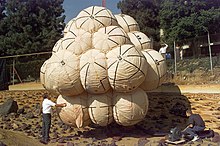

This article needs additional citations for verification. Please help improve this articlebyadding citations to reliable sources. Unsourced material may be challenged and removed.
Find sources: "Lithobraking" – news · newspapers · books · scholar · JSTOR (August 2007) (Learn how and when to remove this message) |
Lithobraking is a landing technique used by unmanned space vehicles to safely reach the surface of a celestial body while reducing landing speed by impact with the body's surface.

The word was probably coined as a whimsical adaptation of aerobraking, which is the process of slowing a space vehicle by the use of aerodynamic drag in a planet's atmosphere. Lithos is a Greek word meaning "rock" or "stone," similarly used in the word lithosphere.
Preparations for lithobraking involve protecting the probe with sufficient cushioning to withstand an impact with the surface and come to rest undamaged. The first successful lithobraking was achieved by the Soviet Luna 9 probe resulting in the first soft landing on the Moon. Unlike the US Surveyor probes that relied entirely on retrorockets, first Luna landers used a combination of retrorockets and gas-filled cushioning bags to reach the lunar surface safely. Soviet and US landers used airbag-like lithobraking for Mars landing missions as well. Alternatively due to extremely dense atmosphere on Venus later generation Venera landers used hard umbrella-like aerobraker in combination with shock absorbers.
Incoming angles are made shallow enough such that the impact has the characteristic of a glancing blow, rather than a direct impact on the surface. In the case of bodies without a sufficiently thick atmosphere (e.g., Mars), lithobraking is typically accompanied by the use of other techniques like retrorocket braking or the use of heat shields and parachutes to reduce speed prior to impact. The Mars Pathfinder and Mars Exploration Rover programs have used this approach successfully.
Alternatively, the incoming velocity can be used to enable the probe to penetrate the surface. This approach can be tried on bodies with low gravitation, such as comets and asteroids, or on planets with atmospheres (by using only small parachutes, or no parachutes at all). Several such missions have been launched, including penetrators on the two Phobos probe landers targeted for Mars' moon Phobos and ones for Mars itself on Mars 96 and Deep Space 2, but so far none have succeeded. The cancelled LUNAR-A probe would have carried penetrators to the Moon.
Lithobraking as a method for de-orbiting a spacecraft has not been used due to the extremely high orbital velocities of most bodies (e.g. for the Moon it is over 7000 km/h). However, some small moons and asteroids have very low gravity and it could conceivably be used there (e.g. Phobos has an escape velocity of 40 km/h.)
Certain concepts involve the spacecraft in an orbit tangent to the surface of the body in question, and "docking" with a magnetically levitated (maglev) train, and the train then slowing.[1] This qualifies as lithobraking, as the reaction mass is the planet itself. This technique requires extremely precise guidance and control, in addition to a large infrastructure, and is thus not yet a viable option – although it may be in the future. An advantage to this method is that it can also launch spacecraft, without needing propellant.
Lithobraking is also used as a humorous euphemism for the result of a spacecraft crashing into the surface of a body with no measures to ensure its survival, either by accident or with intent.[2] This usage is popular among fans of the game Kerbal Space Program, where unintentional use of lithobraking is a common gameplay experience, and is reference in the Kerbal Space Program 2 announcement trailer, where the tagline is "Lithobraking near you in 2020"